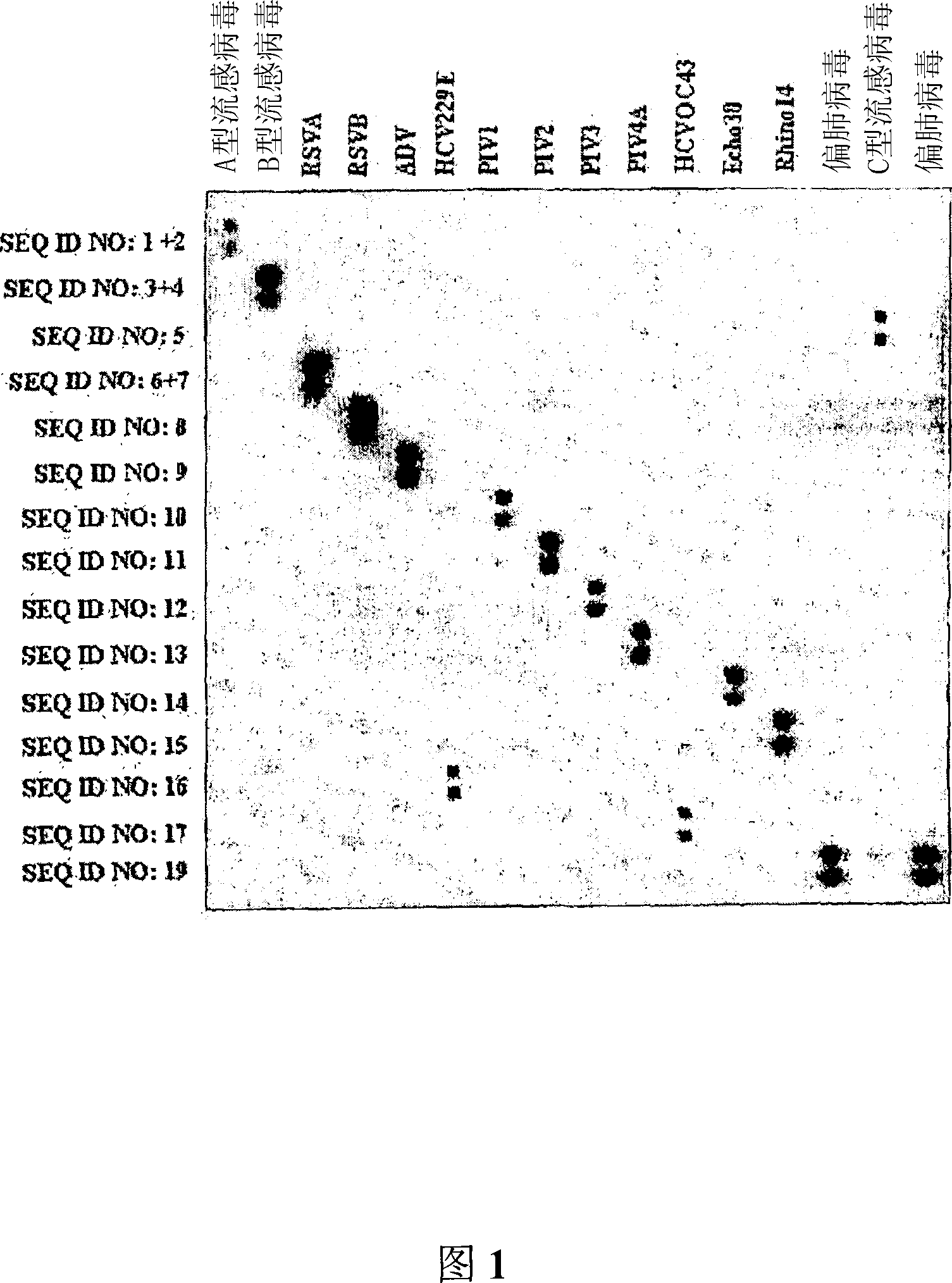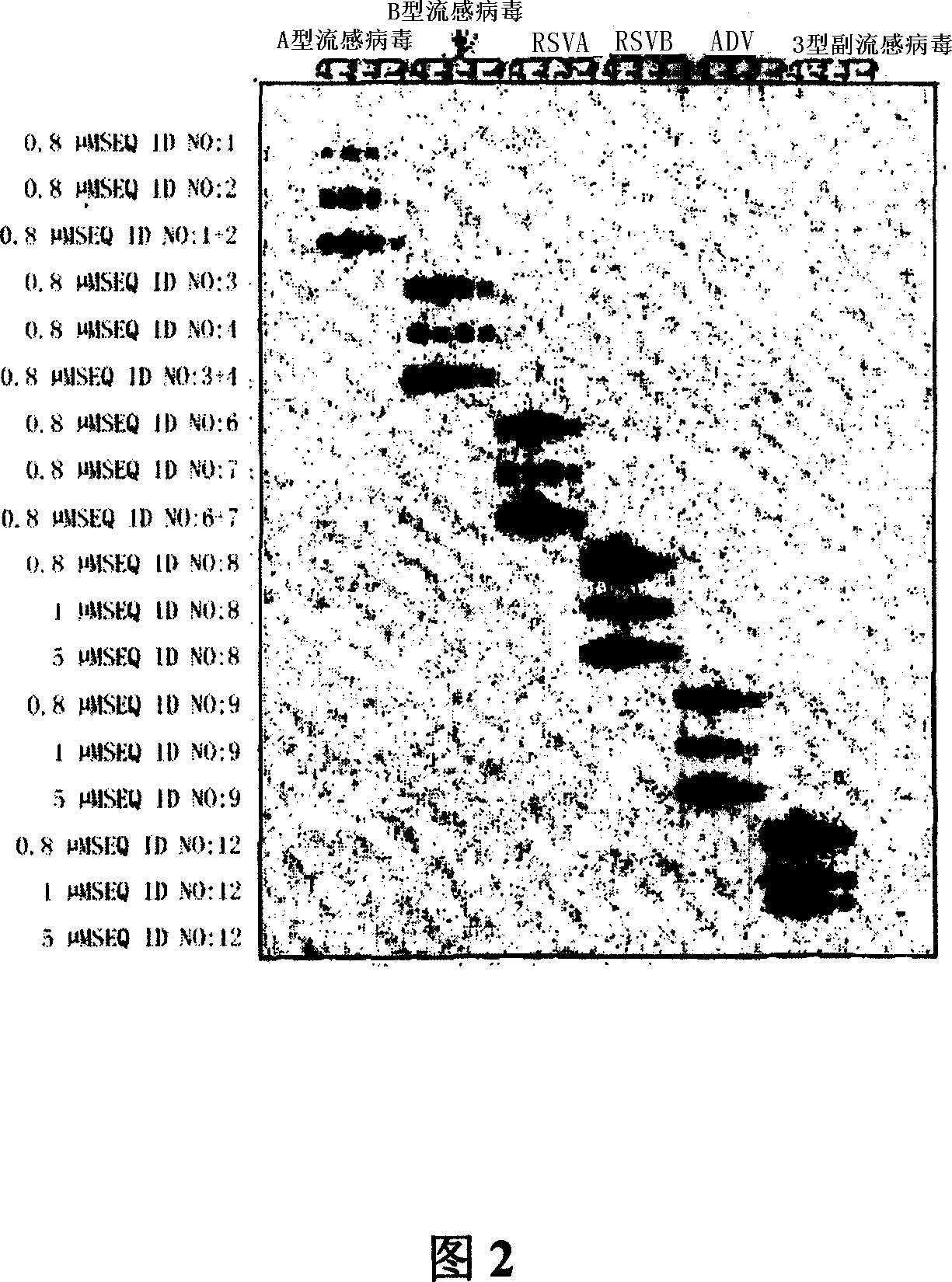Probes and methods for the simultaneous detection and identification of multiple viruses that cause respiratory infections in humans
A technology for human parainfluenza virus and influenza virus, which is used in the field of probes and detection of most nucleic acid sequences, and can solve the problems of false positives and difficulty in isolating viruses.
- Summary
- Abstract
- Description
- Claims
- Application Information
AI Technical Summary
Problems solved by technology
Method used
Image
Examples
Embodiment 1
[0132] Detection of reference strains of viral pathogens causing respiratory infections from cell cultures
[0133] Detection of reference strains of viral pathogens causing respiratory infections from samples of cell cultures inoculated with the above strains is performed by an assay based on the interaction of amplified and labeled genetic material with probes immobilized on nylon membranes For hybridization, the method already reported by Kaufhold et al. (Kaufhold et al., 1994, FEMS Microbiology Letters "FEMS Microbiology Letters" 119: 19-25) was used.
[0134] 1.1 Materials
[0135] 1.1.1 sample
[0136] Samples for this test were collected from cell cultured reference strains of viruses that cause respiratory tract infections. The reference strains are provided by well-known laboratories, and these reference strains are virus reference strains widely accepted by the international scientific community. The list is as follows:
[0137] Virus virus strain
[0138]...
Embodiment 2
[0183] Detection of Respiratory Viruses in Clinical Samples Isolated from Respiratory Tract Infected Cell Cultures
[0184] Detection of different respiratory viruses causing respiratory infections from cell cultures was performed by an assay based on the hybridization of fragments of biotinylated genetic material to probes immobilized on nylon membranes.
[0185] 2.1 Materials
[0186] 2.1.1 sample
[0187] The samples used in this assay are those that cause respiratory infections, isolated from respiratory viruses inoculated in cell culture respiratory clinical samples. The viruses are as follows: influenza A virus, influenza B virus, human respiratory syncytial virus type A (RSVA), human respiratory syncytial virus type B (RSVB), human adenovirus (ADV) (several serotypes), Human parainfluenza virus type 3 (PIV3).
[0188] To examine the sensitivity of the technique, serial 10-fold dilutions of virus isolated from cell cultures of patient respiratory samples were used. ...
Embodiment 3
[0213] Detection of Influenza A Viruses Emerging in Clinical Samples
[0214] The method used for the direct detection of influenza A virus present in clinical test samples is an assay that hybridizes amplified and labeled genetic material to probes immobilized on nylon membranes.
[0215] 3.1 Materials
[0216] 3.1.1 sample
[0217] The samples used for this test are taken from throat smears of patients with flu symptoms in order to identify the virus causing the symptoms.
[0218] 3.1.2 probe
[0219] The probes used in this assay (SEQ ID NO: 1 and SEQ ID NO: 2) were designed with a hexylated amino acid group at the 5' end as reported by Kaufhold et al. (FEMS Microbiol Lett. "FEMS Microbiology Letters" 1994 Jun 1;119(1-2):19-25). The presence of this hexylated amino group facilitates probe immobilization and spatial ordering of the probes on the membrane. In order to immobilize the probe on the membrane, the probe should be washed with fresh pH 8.4, 500mM NaHCO 3 So...
PUM
 Login to View More
Login to View More Abstract
Description
Claims
Application Information
 Login to View More
Login to View More - R&D
- Intellectual Property
- Life Sciences
- Materials
- Tech Scout
- Unparalleled Data Quality
- Higher Quality Content
- 60% Fewer Hallucinations
Browse by: Latest US Patents, China's latest patents, Technical Efficacy Thesaurus, Application Domain, Technology Topic, Popular Technical Reports.
© 2025 PatSnap. All rights reserved.Legal|Privacy policy|Modern Slavery Act Transparency Statement|Sitemap|About US| Contact US: help@patsnap.com



